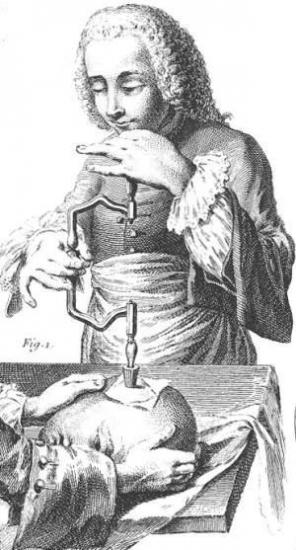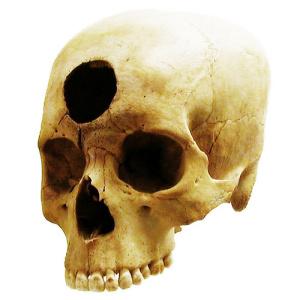Katy Meyers
Source - http://www.bonesdontlie.com/

Illustration from trepanation in France, via Wikimedia
Trepanation is one of the more interesting osteological finds, and it has fascinated the archaeological world since the mid-19th century when Ephraim Squier discovered a trepanned skull in Cuzco, Peru. Trepanation is the removal of a piece of bone from the cranium of a living individual. In human skeletal remains, it appears as various types of holes in the skull from bored circles to cut squares. It can be done with a variety of methods, but all involve removal of a piece of skull. Despite it being a difficult and delicate procedure, it is a fairly widespread type of operation, and was likely independently invented in a number of cultures. Most frequently, trepanation is found in Peru, Bolivia, Africa and Central Europe. The earliest trepanation dates to 6500 BCE and is found in France. This type of surgery, now known as craniometry, is still practiced today for cranial trauma. The goal is release of pressure in the skull, whether it is due to trauma or more psychological or mythical reasons like enchantments or exorcisms.
A new study by Kurin (2013) evaluates the use of trepanation in Late Intermediate Period Peru (1000–1250 CE). She argues that if trepanation is an important surgery intended to aid with trauma, then in eras where violence and stress is high, there should be higher rates of the performance of this type of surgical procedure. The Late Intermediate Period had one of the highest rates of violence, worsening drought, and followed the collapse of the Wari Empire. The fragmentation of the empire led to a political vacuum that provoked social instability and civil unrest.While violence was widespread, it was not experienced equally- there are higher rates of trauma among individuals from specific social groupings. These types of situations increase the development of medical technology, and trepanation may have increased because of the high levels of physical conflict and scarcity.

Nazca-Peruvian skull operation from 2000 years ago presumably to relieve a front cavity inflammation, via Tsai Project on Flickr
The sample of human remains comes from five sites in modern Andahualas and Chincherros Provinces in highland Peru. The human remains were commingled and belong to at least 477 individuals, however only crania were examined for this study. In total 256 skulls were examined for trepanation. All crania were examined for trauma, pathological lesions, and trepanation, as well as demographic information such as sex and age. The trepanations were assessed for type, size and shape of the surgery. Trepanations can be done through scraping, beveling, circular grooving or cutting, boring, drilling or linear cutting. They can also be completely perforating the bone or incomplete. Location can be found throughout the cranium. Healing of the injury was also categorized whether they were completely unhealed or in a stage of healing and remodeling. Other injuries around the trepanation were recorded in order to determine whether they were related to the surgery.
Of the 284 crania, 32 had at least one or more attempted or completed trepanation surgeries. 9 of the individuals had multiple perforations. There were four methods used: scraping was found on 26, circular grooving on 9, boring and drilling on 11, and linear cutting on 1. She found that trepanations were primarily found on the left parietal bone as this area lacks major veins, muscles, cavities and sutures. However, 10 of the trepanations impacted sutures, 18 impacted muscles, and 3 were on the frontal bone near the sinuses. 30 of the 45 trepanations show signs of healing, either short or long term, and in general scraping trepanations were the most successful. Drilling and boring techniques were highly unsuccessful, and only 1 of 11 showed evidence for short term healing. Half of the individuals inspected had some type of cranial trauma near the trepanation, suggesting that the two were related, and 3 had trepanations directly over fractures. 3 individuals also had evidence of inflamed porotic bone suggesting a need for medieval treatment related to disease or malnutrition. Most interesting is that there is one individual who shows signs of trepanation occurring after death in an experimental manner suggesting that medical practitioners were practicing on them after they had died.
Kurin (2013) concludes that trepanation became an important medical procedure in this period due to the increase in violence, pathology and instability. Trepanations were most often done through scraping as it was a successful endeavour, and were usually associated with cranial trauma. The high level of success and similarity in techniques at the different sites suggest that there was a common understanding of how it was done and knowledge was traded. Further, there is evidence for practicing and developing the technique on the deceased. It would be interesting at some point to see a modern study about ancient trepanation techniques…
You can learn more about different types of trepanation here: Hole in the Head: Trepanation.
Works Cited
Kurin DS (2013). Trepanation in South-Central Peru during the early late intermediate period (ca. AD 1000-1250). American journal of physical anthropology, 152 (4), 484-94 PMID: 24142537